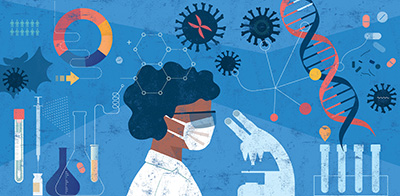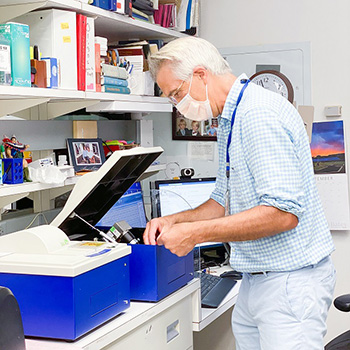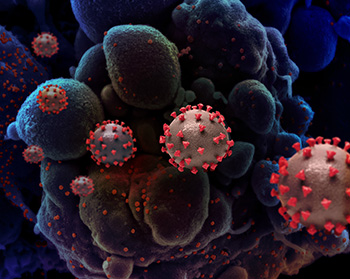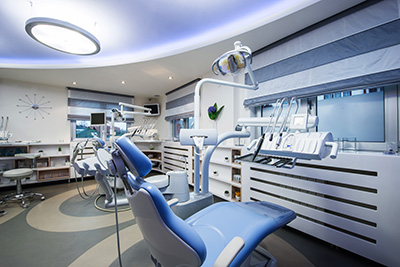Legacies of the Pandemic
COVID-19 thrusts NIDCR research into the spotlight
In early 2020, the race was on — between scientists and an elusive new virus called SARS-CoV-2. The virus sparked a worldwide pandemic, scorching through nations and sickening hundreds of millions with a disease now called COVID-19. In the United States alone, the pandemic has claimed over 1 million lives, hospitalized more than 6 million, and sickened tens of millions.
Scientists around the globe mobilized to end the turmoil. From unravelling the genome of SARS-CoV-2 to developing life-saving vaccines based on decades of foundational work, researchers and clinicians forged a path to the new normal we know today. Among them were NIDCR-supported scientists who pivoted from their regular work to study SARS-CoV-2 infection processes and invent new testing methods to monitor the spread of the virus.
“In the beginning, we knew so little about the virus — how readily it spread, who was most susceptible, who was at risk of a bad outcome,” said NIDCR Associate Scientific Director Kelly Ten Hagen, Ph.D. “People wanted to contribute to something that might help us understand how this deadly virus was working.”
Antibody Test Yields Answers
Just weeks after the virus took hold in the U.S., NIDCR staff scientist Peter Burbelo, Ph.D., designed tests to detect SARS-CoV-2-fighting proteins, or antibodies, made in response to infection. Unlike tests that provide a simple positive or negative result, Dr. Burbelo’s test measures the precise quantity of these antibodies in a blood sample. That kind of information can help scientists better understand the development and duration of immunity.
Throughout the pandemic, Dr. Burbelo has collaborated with other researchers to contribute data from his test to 28 published studies to answer questions about genetic susceptibility to severe COVID-19, vaccine efficacy in vulnerable populations, and behavioral factors that drive SARS-CoV-2 spread in households.
Mouth Reveals Mystery of Viral Spread
The ability to spread stealthily is one of SARS-CoV-2’s most vexing traits. The virus hitches a ride in droplets expelled as we cough, sneeze, talk, and breathe. Saliva is a key virus-carrying fluid. Until recently, though, scientists didn’t entirely know where SARS-CoV-2 in the saliva comes from, especially in people without symptoms who don’t cough up virus from the lungs, a primary infection site.
It turns out the virus can infect cells in the mouth and be shed into saliva, according to a study co-led by NIDCR investigator Blake Warner, D.D.S., Ph.D. The team found evidence of SARS-CoV-2 infection in the salivary glands and in oral tissue shed into the saliva of people with COVID-19. The scientists also showed that healthy cells could be infected by the saliva of people who tested positive for COVID-19 but lacked symptoms.
The findings suggest the mouth plays a bigger role in spreading SARS-CoV-2 than previously thought and may help explain COVID-19 symptoms such as taste loss, dry mouth, and ulcers. This knowledge may lead to better interventions against viral transmission and public health measures.
Shedding Light on Virus Variants
Despite our growing knowledge about COVID-19, one challenge that remains is the virus’s ability to outsmart our immune system, treatments, and vaccines by mutating. A study led by Dr. Ten Hagen offers insight into how mutated virus strains like the alpha and delta variants, which emerged in 2021, may outwit our body’s defenses. Dr. Ten Hagen’s team focused on the dart-like structures, called spike proteins, that pepper the virus’s surface and help it invade cells. Using mammalian and fruit fly cells, the scientists compared the infective abilities of spike proteins from the original, or wild-type strain of the virus, to those from the alpha and delta variants.
They found that wild type spike protein activity was partly suppressed by an enzyme called GALNT1. GALNT1 belongs to a family of enzymes found in most animals that makes chemical changes to proteins to ensure proper cell development and function. GALNT1’s dampening effects, however, were overcome by mutations to the alpha and delta spike proteins, leaving their infective functions intact. These findings offer potential clues as to how new variants of SARS-CoV-2 infect and spread more easily. The work could also open doors for future therapies.
These projects are just a few of the ways NIDCR researchers are laying the groundwork for combatting COVID-19.
“NIDCR investigators’ collective multidisciplinary expertise allowed us to investigate the many facets of SARS-CoV-2 biology,” said Dr. Warner. “This served as an opportunity to support the nationwide public health efforts to address the pandemic.”
Developing Tools to Surveil SARS-CoV-2
In addition to untangling the biological intricacies of SARS-CoV-2 infection, scientists on NIDCR-supported projects are looking for ways to prevent outbreaks in the first place. In 2020, NIDCR issued millions in rapid funding for COVID-19 research through the NIH-wide Rapid Acceleration of Diagnostics Radical (RADx-rad) initiative and the National Dental Practice-Based Research Network. These studies seek to address critical needs, such as optimizing virus detection and minimizing infection risk in dental environments.
From a “smart mask” that changes color when exposed to the virus to electronic “noses” that sniff out viruses, the NIDCR-supported studies use innovative, non-traditional approaches to detect SARS-CoV-2. The aim is to develop rapid, affordable, and accessible testing and surveillance methods that can be applied in schools, nursing homes, and other group settings. For example, the smart mask showed feasibility in capturing and detecting the virus in wearers’ saliva or breath for infection surveillance. Diagnostics like these might even be adapted to detect other diseases, such as fungal infections and cancers.
“COVID really accelerated development of these detection approaches to a point where their feasibility has been demonstrated, and they have the potential to be commercialized,” said NIDCR program officer Orlando Lopez, Ph.D., who co-manages the institute’s RADx-rad projects. “This is exciting, because it opens up possibilities in sensing technology that have not been previously available.”
Other researchers are studying ways to mitigate the spread of tiny, mist-like droplets, or aerosols, generated during dental procedures that can carry viruses and linger in the air. The work may inform strategies to better protect dental providers and patients from SARS-CoV-2 and other viruses.
“NIDCR-supported COVID-19 research has contributed valuable knowledge to the global scientific effort to end the pandemic,” said NIDCR Director Rena D’Souza, D.D.S., Ph.D. “This progress reflects the institute’s commitment to advance all domains of research along the entire translational continuum to improve the health and well-being of everyone.”
While the COVID-19 public health emergency declaration expired in May, scientists say the virus is here to stay. Even as widespread immunity has lessened its severity, the virus will continue to mutate and evolve, as viruses do. Continued research will inform better therapies, address COVID-19’s disproportionate toll on certain communities, and answer questions about Long COVID, a condition in which COVID-19 patients experience wide-ranging symptoms including brain fog, loss of taste or smell, and shortness of breath, which can last months or years. Most importantly, these advances will prepare us for the next pandemic.
“History has shown repeatedly that fundamental research can point the way for clinical discovery,” said Dr. Ten Hagen. “This was vividly illustrated during the pandemic.”
Related Links
- Scientists Identify Mechanism That May Influence Infectivity of SARS-CoV-2 Variants
- Developing a Smart Mask to Surveil Coronavirus
- Scientists Find Evidence that Novel Coronavirus Infects the Mouth’s Cells
References
Burbelo PD, Riedo FX, Morishima C, Rawlings S, Smith D, Das S, et al. Sensitivity in Detection of Antibodies to Nucleocapsid and Spike Proteins of Severe Acute Respiratory Syndrome Coronavirus 2 in Patients With Coronavirus Disease 2019. J Infect Dis. 2020 Jun 29;222(2):206-213. doi: 10.1093/infdis/jiaa273.
Huang N, Pérez P, Kato T, Mikami Y, Okuda K, Gilmore RC, et al. SARS-CoV-2 infection of the oral cavity and saliva. Nat Med. 2021 May;27(5):892-903. doi: 10.1038/s41591-021-01296-8. Epub 2021 Mar 25.
Zhang L, Mann M, Syed ZA, Reynolds HM, Tian E, Samara NL, et al. Furin cleavage of the SARS-CoV-2 spike is modulated by O-glycosylation. Proc Natl Acad Sci U S A. 2021 Nov 23;118(47):e2109905118. doi: 10.1073/pnas.2109905118.
Sun, K., Loria, V., Aparicio, A., Porras, C., Vanegas, J.C., Zúñiga, M., et al. Behavioral factors and SARS-CoV-2 transmission heterogeneity within a household cohort in Costa Rica. Communications Medicine, in press, 2023.
Attention Editors
Reprint this article in your own publication or post to your website. NIDCR News articles are not copyrighted. Please acknowledge NIH's National Institute of Dental and Craniofacial Research as the source.
Subscribe for NIDCR Updates
Receive email updates about the latest advances in dental, oral, and craniofacial research.
November 2024




